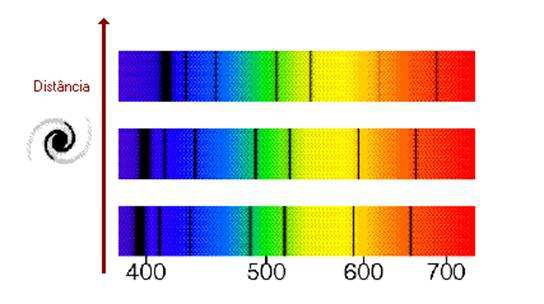Viajando à mesma velocidade de outro objeto não notamos o nosso estado de movimento em relação a esse corpo.
Porque é que Hublle pensou que o Universo se está a expandir? Afinal nós estamos num movimento de expansão simultânea com as restantes galáxias que ele vê a se afastarem. Só poderia ver isso se a Via Láctea estivesse estática.
Ao examinar a luz emitida por galáxias distantes Edwin Hubble verificou, em 1929, que esta aparecia sempre desviada para o vermelho. Este fenómeno é conhecido por efeito Doppler e acontece sempre que observamos um objeto que se afasta de nós. Isto significa que todas essas galáxias estão a afastar-se da Nossa Galáxia. Verificou ainda que quanto maior a distância maior é a velocidade de afastamento. Apenas para algumas galáxias do chamado Grupo Local acontecia o inverso, ou seja, o desvio para o azul (galáxia em aproximação).

Fig. 1
A conclusão lógica a tirar desta observação é a de que o Universo está em expansão. Não significa que a Nossa Gaáxia fica estática no centro. Como o Universo quando visto em larga escala é homogéneo e isotrópico qualquer observador em qualquer ponto do Universo (ou seja em qualquer outra galáxia) faz a mesma leitura relativamente à expansão: para ele todas as galáxias distantes (incluindo a Nossa Galáxia) estão a afastar-se da sua própria galáxia. Suponhamos que as galáxias são pontos sobre a superfície de um balão. Ao encher o balão de ar cada um desses pontos afasta-se progressivamente dos demais.

Fig. 2
Para mais detalhes ver (em particular o capítulo 3):
Da Relatividade Geral à Cosmologia Contemporânea
Traveling at the same speed as another object, we do not notice our state of motion relative to that body. Why did Hubble think the Universe is expanding? After all, we are in a movement of simultaneous expansion with the remaining galaxies that he sees moving away. You could only see this if the Milky Way was static.
When examining the light emitted by distant galaxies, Edwin Hubble found, in 1929, that it always appeared red-shifted. This phenomenon is known as the Doppler effect, and it happens whenever we observe an object moving away from (redshift) or towards us (blueshift). This means that all these galaxies are moving away from Our Galaxy. He also found that the greater the distance, the greater the apparent velocity. Only some galaxies, from the so-called Local Group, displayed a blueshift (see Fig. 1)
The logical conclusion to be drawn from this observation is that the Universe is expanding. It doesn't mean that Our Galaxy remains static in the center. As the Universe, when seen on a large scale, is homogeneous and isotropic, any observer at any point in the Universe (that is, in any other galaxy) makes the same remark, regarding expansion: for him, all distant galaxies (including Our Galaxy) are moving away from their own galaxy. Suppose galaxies are points on the surface of a balloon. When inflating the balloon with air, each of these points progressively moves away from the others (see Fig. 2)
For more details on this, see Chapter 3 of our work "From General Relativity to Current Cosmology" (in portuguese):
Da Relatividade Geral à Cosmologia Contemporânea

